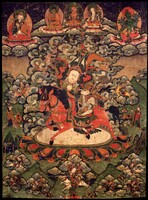King Gesar Main Page - Updated

Gesar is a folk hero of Eastern Tibet and predominantly known through literature and live performance. He is believed to have lived around the 10th century. The stories of Gesar, epic in size, are brought to life through dramatic performances, song and public readings of his many adventures. It is quite possibly the longest epic poetry in the world. Despite the popularity of all of this there is relatively little found in the way of art: paintings, murals and sculpture. What objects are known are also dated very late - 19th and 20th centuries. In the 19th century a Nyingma teacher of East Tibet, Mipam Jamyang Namgyal Gyamtso (1846-1912), further popularized Gesar but as a Buddhist religious figure - a deity - creating rituals, meditations and even a divination system with a one month required retreat. Most of the art objects that are currently known appear to be related or inspired by the writings of Mipam.
There are three sets of early Gesar life story paintings known to exist: Le Guimet in Paris with 10 paintings (?), Sichuan Provincial Museum with 11 paintings and the Rubin Museum of Art in New York with one painting. The Guimet set was acquired in approximately 1910 and the Sichuan Museum set in approximately the mid part of the last century. The first two sets are almost identical and obviously copies from the same composition. It is not yet determined which is the earlier of the two sets or whether they were both copied from another (3rd) master set. However both sets can be safely dated to prior to 1910.
The central subject of the Rubin Museum painting is of the uncle of Gesar and obviously from a larger set of compositions depicting all of the major cast of characters in the life story. Aside from the images depicted on HAR there is a single painting depicting Gesar and the eight retinue generals in the collection of the Sichuan University and another two in a private collection in Chengdu. At least two sculpture of Gesar are also known. Both are of the same subject - a peaceful figure, wearing a tall cylindrical hat, seated on a cushion with one leg extended. There are many modern Gesar images in painting and sculpture. Undoubtedly more objects with a slightly less than modern provenance will be located in other collections - institution or private.
The general depiction of Gesar is of a Tibetan warrior, atop a horse, clad in armor and a helmet with elaborate flag pennants and streamers, accompanied by eight horseman. This description is almost identical to that of Dralha 'Enemy God'. It is very easy to confuse the two subjects of Gesar and Dralha. Also look at another similar figure (HAR #73433) which is not yet identified.
Painting Sets:
1. Le Guimet, Paris, France
2. Sichuan Provincial Museum, Chengdu, China (11 paintings)
3. Rubin Museum of Art, New York, USA (1 painting)
